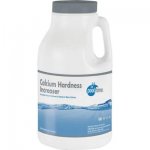Hey tim5055 - Yes, I was asking them about deicer (specifically Tetra Flake since that's what I found online that HD carries and pool school mentioned by name). The price was $10 for a 50 lb bag. Glad you included that you used to live in Severna Park; I was wondering when I was reading your post how you knew Defense Hwy.
Thanks for checking Defense Hwy store; that was really nice of you. Their price is higher. $11/5 lb x 5 = $55 vs Leslie's 25 lbs for $47.
Big price difference between "decier" and "pool hardness increaser" but I'll take some solace in getting it cheaper at Leslies rather than think about how much more I spent because it's got some fancy pool stuff name. haha
I'm going to start adding some to the pool so I'd still welcome anyone's input on target, calculations and adding.
Thanks for checking Defense Hwy store; that was really nice of you. Their price is higher. $11/5 lb x 5 = $55 vs Leslie's 25 lbs for $47.
Big price difference between "decier" and "pool hardness increaser" but I'll take some solace in getting it cheaper at Leslies rather than think about how much more I spent because it's got some fancy pool stuff name. haha
I'm going to start adding some to the pool so I'd still welcome anyone's input on target, calculations and adding.




